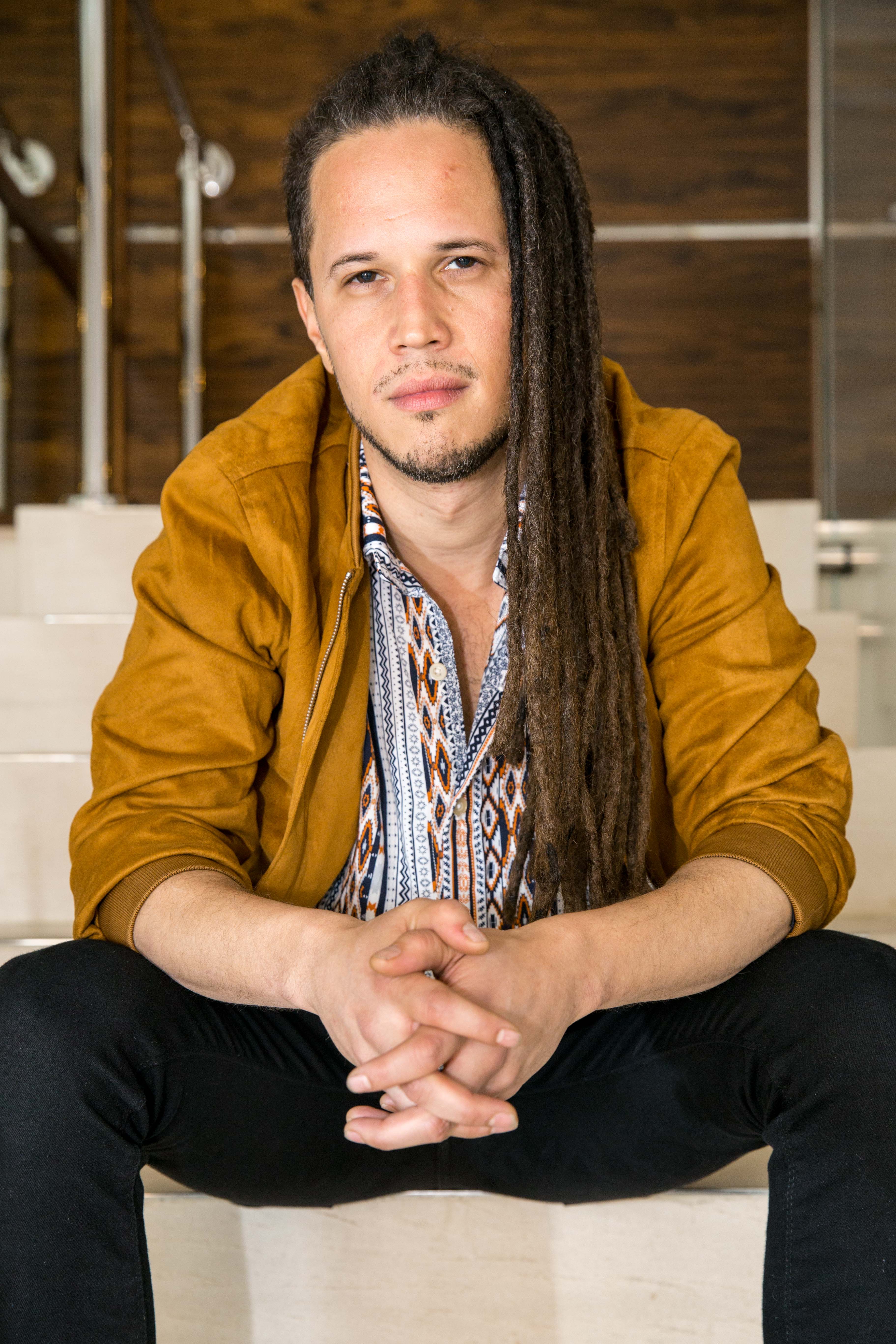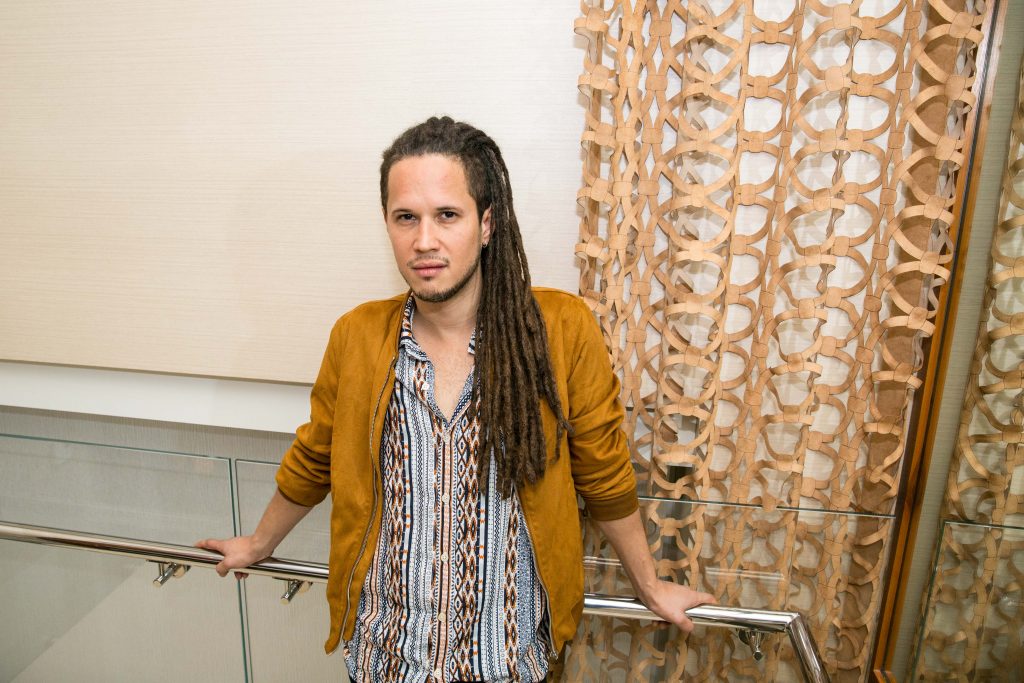2017 was a charmed year for Dominican pop sensation Vicente García. Buzzy singles like “Carmesí” and “Dulcito e Coco” rang in our ears with García’s wise and luminous love of Afro-Caribbean rhythms, and his three wins at last November’s Latin Grammys – including the coveted Best New Artist trophy – cemented his place as one of the brightest rising stars in mainstream Latin music. But García is so much more than a simple pop crooner. His music speaks of love and journeying, both physically and spiritually, placing a profound reverence of the deep African roots of Dominican music at the center of it all.
In today’s music landscape, there’s a rising tide of Latino artists looking to roots music for inspiration and self-actualization, while labels and producers scour the underground for the next big sonic trend. Vicente García is often compared to artists like Flor de Toloache and Rosalía for bringing visibility to the new generation of folk pop revivalists helping to reimagine these genres.

“Since I started my solo career, I knew I wanted to work through bachata,” he tells Remezcla in an interview in Las Vegas right before the Latin Grammys. “I wanted to move my generation closer to a type of music that isn’t as beloved anymore – music that isn’t perceived as cool or chevere – and have them hear it differently.” Pointing out early influences from hard rock and funk legends like Rage Against The Machine, Tool, and Stevie Wonder, García soon felt the urge to put his own identity into the sound. “I’d never paid much attention to the music of my country because of this idea of ‘uncoolness.’ That thought triggered an uneasiness I wanted to express in my music. An invitation, of sorts, to submerge ourselves in our culture.”
García began his exploration with 2011’s Melodrama, a collection of eclectic love songs that collided Caribbean genres like salsa, bachata, and reggae with tinges of rock guitar and funk horns. But despite García’s already diverse sonic palette, the urge to look further inward only grew. “What I started on Melodrama, I deepened on A La Mar,” he says. “Besides bachata, I began working with genres that are still quite hidden and overlooked by young people. I took an interest in Dominican folklore, specifically the framework behind merengue and bachata. I began going to parties where they would perform palo music and other magico-religious ceremonies, traditions that were completely ignored by the circles I came up in, which favored North American references.”
The product of diligent research, contemplation, and experimentation, A La Mar is a rich and immersive musical document that reflects on García’s far-reaching existential queries. You’ll find a hymn to displacement in “Pa Nuevayor,” East African guitar picking and rare bambula drumming in “She Prays,” and some classic bachata sabrosura on “Mal de Amore.” The record’s lyrics and nostalgic sourcing of lesser-known Dominican genres were also largely due to García’s challenging relocation to Bogotá.
“I wanted to move my generation closer to a type of music that isn’t as beloved anymore.”
“I think this record, A La Mar, has such a strong Dominican feel because I wasn’t there anymore,” he explains. “I genuinely missed my country and wanted to recreate those emotions with the lyrics and the music of where I came from. This record completely gives shape to the dominicanidad I was missing so dearly.”
The theme of displacement is laid exquisitely bare in García’s two latest videos, a set of parallel stories directed by Santiago Díaz-Vence. “Bachata en Kingston” features a couple living modestly in Bogotá with little more to their name than music and a home full of shared memories. Though the pair is seemingly happy and in love, the video ends in heartbreak, with the young man finding his girl has left home without warning. The new video for “Espuma y Arrecife” tells the other side of the story, revealing her unhappiness as she feels her identity and roots suffocated under Bogotá’s overwhelming urban sprawl. Cathartic drum breaks illustrate the young woman’s longing for her life back on the coast, a reflection of García’s own homesickness, also symbolizing the sacrifices made by people who migrate to cities in search of opportunity and fortune and often find the costs outweigh the rewards.
Though García is candid about his nostalgia for home, he never doubted his ability to thrive in Colombia, pointing out the golden status of merengue and bachata in local party culture. “Colombia is a country that consumes lots of Dominican music,” he says. “I would almost go as far to say the average Colombian youth knows more about 80s and 90s merengue than many Dominicans. And I’m not just talking about Juan Luis [Guerra] or Wilfrido [Vargas], they also know Bonny Cepeda and Mickey Taveras, acts that may not have been huge, but still made an impact on the movement.”
But in order to tell an innately Dominican musical story while off the island, García had to find musicians who could capture that distinct and elusive grajo. “I was lucky to find musicians who’d studied Dominican music before we’d even met,” he says. “One of our percussionists, Diego Carabi, has been immersed in this stuff since the 90s, and he’s brilliant! This small nucleus I’ve created possesses intimate knowledge of Dominican culture and has infected the rest of the group. Our guitarist used to not play bachata but he got it together when he saw everyone was already on board.” He adds with a chuckle, “I’ll play them some essential grajo records so they can sift through it and keep the good stuff.”
Like a Caribbean sea current, Vicente García feels the vibrant pull of his culture regardless of geography. This lure is an amalgamation of music, ancestry, and empathy that converges in an ardor for honest human connection. “Following these Afro-descended rhythms led to a lot more understanding about society, about how we see people en el campo, and how we establish conversations and friendships. I think it’s beautiful how this musical search evolved into social meaning, into loving my country and where I come from, all the way back to my grandparents in Puerto Plata. It’s the duty of music to get these cultures to meet and look into each other.”
Stream an exclusive playlist from Vicente Garcia featuring deep cuts and influences from his childhood:
Catch Vicente García on tour below:
February 2 – Vivo Beach Club – San Juan, PR
February 22 – Irving Plaza – New York, NY
February 27 – Troubadour – Los Angeles, CA







